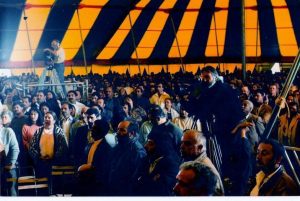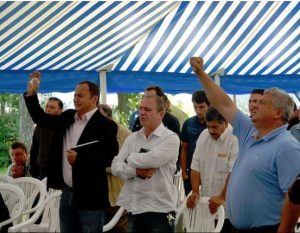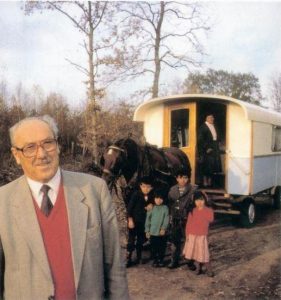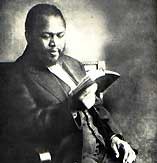The vocation of Clément Le Cossec
Clément Le Cossec, pastor of the Assemblies of God in Lille, met members of the gypsy community in 1950. While co-ordinating a local Pentecostal group in Brest he met another Gypsy community who were rejected by many ministers in their churches as their baptism was not considered acceptable. Without any official training self-appoint ted pastors baptized in the name of the Holy Spirit.
Clément Le Cossec decided to come to their aid.
While still remaining a missionary for the Church of the Assemblies of God, he also converted three thousand gypsies and undertook to give them the support they needed:
“Le Cossec discovered that his role in life was to be a missionary to French gypsies”. He then set about training pastors and preachers chosen from the gypsy community who soon became leaders of family groups and missions. He had to establish “mobile Churches” and train leaders capable of conducting a dialogue with the public authorities.
The beginning of the Gypsy Mission
The Gypsies (later called the Travellers by the administration) discovered Protestantism for the first time in France in the 1950’s. The first Protestant Gypsy association to come into being was called “Deliverance: the Gypsy Evangelical Mission in France” which was founded on 28 December 1957.
Later the General Assembly held on 26 February 1961 decided to call it “The Gypsy Evangelical Mission in France, Life and Light”. It mainly concerned Gypsies from all the existing groups at the time: Manouche, Sintis, Gitans, Yeniches and Roms and its aim was to announce the Gospel in France and all over the world. In 1975 the Mission became an official member of the French Protestant Federation, who united together many separate Churches. Since this date Gypsy pastors have always taken part in the Council of the Federation.
There has been a succession of different general secretaries. There was Pastor Honoré Martin from 1961 – 1986, then Pastor Wasso Ferret, known as Balo was the second general secretary of the Gypsy Mission, Life and Light from 1986 – 2005 – he took part in several negociations with successive Ministers of the Interior. In 1997, he organized the first preparatory meeting for the “Long Journeys”: representatives from local authorities were invited to meet leaders of the Gypsy groups at a meeting in Neroy (Loiret). Mario Holderbaum has been general secretary since 2005.
Pastor George Meyer, known as Jimmy, was publicly recognized for his enormous contribution to the success of the Gypsy Evangelical Mission in France, Life and Light, as its President. He was given the “Légion d’Honneur”by Bernard Cazenove, the Minister of the Interior and Religious Matters on 14th January 2015.
In 2018, there were more than 120 000 evangelical Gypsies in France, which is to say about 40% of all French Travellers, under the leadership of 2351 pastors and preachers. In France, the Mission also consists of 320 Churches who assist many families settling in for the winter in different locations. Some assemblies have as many as 500 members, who are kept in contact with the Mission in this way.
The tradition of “Long Journeys”
Every year starts with a traditional spring meeting in Nevoy which gathers together more than 500 caravans (30 000 to 35 000 people). This is when families prepare to disperse later in the summer: groups of itinerant Gypsies are organized into different “missions” or “conventions” with the aim of both linking up with their families and evangelizing; they go to more than 1 000 towns over a period of several months, from the beginning of May until the end of August. Nearly 200 groups of more than150 caravans park their vehicles and put up their marquees or tents in specially allocated areas such as municipal car parks. They stay for about a fortnight and then move on.
These “Long Journeys” refer to the Gypsies constant, wanderings all over France and they are organized with the support of the Minister of the Interior. Traditionally there is another last great assembly of the Gypsy community at the end of the summer.
Pastoral training
The first Bible College for the training of pastors was set up in 1966 in the Loiret. In 1978 the training centre for preachers moved to the Cher, where it stayed until 1988, when the Life and Light International College returned to the Loiret, setting up its buildings on a 128 hectare plot of land that had been bought by the Association for the main annual meetings.
An organization for social and educational action
In the nineteen sixties, the National and International Association for Social Action in the Gypsy Community was organized.”Its role was to help every racial group and every religion to be found in the Gypsy community (Manouche, Sinti, Gitan, Yeniche, Rom) and to travelers who shared the same life style. Its purpose was to guarantee a global project which established the acceptance of Gypsies by the society as a whole and providing support which would enable their families to obtain a decent standard of living. Its ultimate aim was to further the wellbeing of Gypsies, to preserve their cultural identity, their way of life and their history.”
They became more integrated into society.
The Association has a role of mediation and support in the Gypsy community; it is a member of the national advisory committee for travelling people. It has employees and voluntary Gypsy mediators in different countries. It participates actively in meetings with Prefects to plan centres in each county where Gypsies can seek assistance and they also negociate to build car parks where caravans can stay. They have worked together with the National Education to create School Caravans in several counties as well as 9 jobs for school mediators.
In 1983, the Gypsy Evangelical Mission, Light and Life, in France started up its own Gypsy Chaplaincy within the Protestant federation. About fifty Gypsy pastors under the leadership of a general chaplain are officially appointed by the Ministry of Justice to work in prisons. There is a service for the reinsertion of prisoners after their release and the possibility of writing letters to their families.
In 2015, a small group of Protestants, not all of whom were Gypsies, gathered together to create the Protestant Association of Gypsies’ Friends. Their aim was to defend the Gypsies’ right to maintain their specific way of life and to encourage links between the different Protestant communities. The association became a member of the French Protestant Federation who recognized it in the category of: a community, charitable association or social movement.
The Evangelical Movement became International
The evangelization movement started by Pastor Le Cossec soon spread into every country in Western Europe. Strong links unite these countries and they also work together with many nations: India, Eastern Europe and the Balkans.
In 2017, the number of evangelical Protestant Gypsies could be estimated as more than a million and a half, living in more than 44 countries throughout the world. Evangelical Protestantism can be found in every group of Gypsies, whether they are Travellers or not.
The Gypsies and Travellers International Evangelical Fellowship is active in social, educational, legal, humanitarian and medical spheres.






